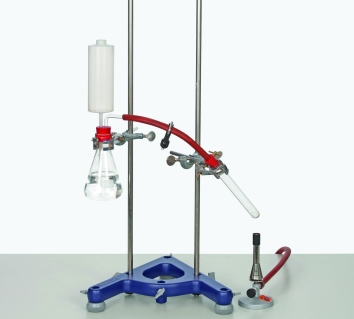Principle
The reduction, as the reversal of the oxidation, can be achieved thermally or with the aid of a reducing agent.
Some metal oxides can be decomposed into the metal and oxygen under the influence of thermal energy. In the case of less noble metals, a reducing agent is required for obtaining the elements. The redox processes during the preparation of lead demonstrate the relationship between oxidation and reduction.
By way of this experiment it can be shown that during the reduction of an oxide the reducing agent itself is oxidised: hydrogen to water, carbon to carbon dioxide. A reduction process is always coupled with an oxidation process, which is why this type of reaction is referred to as a redox reaction.
Benefits
- Practical gas bar for storing the gases
- Stable and safe setup due to solid stand material
Tasks
- Reduction of lead(IV) oxide to lead(II) oxide by thermolysis.
- Reduction of lead(II) oxide by way of charcoal to obtain elementary lead.
- Reduction of iron oxide including the formation of hydrogen based on pyrophoric iron.
Learning objectives
- Reduction
- Oxidation
- Redox reaction
- Lead
- Iron
- Thermolysis

